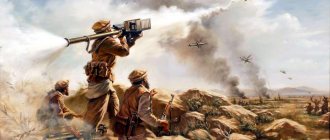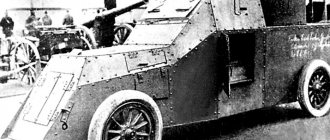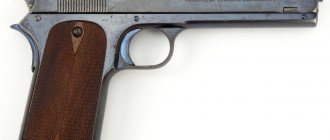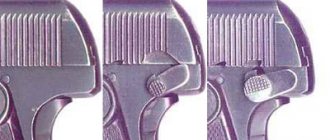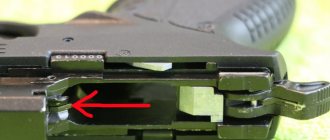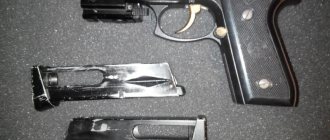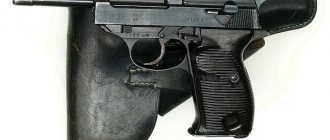Considering the technical characteristics of the TT pistol, it is worth noting that the weight is 910 g, in turn, the length is 116 mm.
The clip is designed for 8 bullets, and the length of the aiming line can be considered within 156 mm. 50 m - sight range. This pistol is zeroed at a distance of 25 m.
The bullet speed is 420 m/s. In the structure of the mechanism, 45 main parts can be distinguished. The pistol operates using recoil energy with a short barrel stroke.
The locking function is carried out by connecting the protrusions of the bolt casing with certain figures on the barrel.
Next, the sliding earring lowers the barrel to the level of the breech, based on this, the barrel and bolt are separated. In TT, all parts of the impact mechanism are combined into one common block. Expert's note: In order to partially disassemble the pistol, no tools are needed, since it is very easy to disassemble.
History of creation
During the formation of the Red Army in the early 20s, the problem of reconstructing weapons in general and private weapons used in close combat arose.
Soviet developers had to develop a pistol that would be suitable for firing 7.63 mm caliber bullets from the Mauser model 1897.
Designers such as Tokarev, Korovin and Prilyutsky participated in the competition held by the government.
Tokarev won by a large margin over his players. Since the first production of the TT was launched in Tula, it was therefore named Tula Tokarev.
Please note: the TT does not have a safety as a separate element of the body; the pistol is secured by setting the trigger to safety.
According to the technical characteristics, it was no match for the military pistols of those times, and even surpassed them in a number of characteristic features.
For example, you can consider Western shooting standards at a distance of 50 m, at which the maximum dispersion allowed is 35.5 cm, although when shooting from a TT, the dispersion distance is 15 cm.
Along with the pistol, 7.62 mm “P” type cartridges (7.62x25 mm), which were made on the basis of the well-known powerful 7.63 mm Mauser cartridge, were also used. However, later various cartridges were introduced, for example with armor-piercing and tracer bullets.
TT pistol configuration
The TT pistol package includes the following elements and parts:
- The barrel is in the form of a cylinder with a tide. It is located at the top of the frame. The internal part has a chamber with a channel where there are 4 notches. They give the bullet rotational advances. A lug with a bevel and a notch facilitates the passage of the ammunition into the chamber. The outer part has ducts for docking.
- The shutter casing is located outside the barrel, in the form of a whole element. Inside there are: a movable barrel, a return spring and components of the impact mechanism. There is a bushing at the front with the muzzle part at the top. When the bolt moves backward, the hammer is cocked, and forward, the cartridge passes into the chamber.
- All the main parts and elements are attached and connected to the frame.
- The shutter with the return spring is located on the top of the frame. It is movable due to the protrusions at the frame.
- Between the handle and the trigger there is a lock for the clip. It regulates the operation of the trigger.
- The trigger looks like a block. It includes a trigger, a hammer, which strikes the striking mechanism. Another element, the sear, cocks the trigger, and the spring sets the trigger to move. The striker looks like a metal cylinder with a needle at the leading edge. A disconnector is designed to protect against shots.
- The bolt stop has a tooth with a rod. When the ammunition is completely consumed, the bolt moves to the upper part, holding the bolt casing in the rear position.
- The cheeks are located on the handle.
- The sighting mechanism is a front sight with a rear sight.
When you press the trigger, the springs come into motion - the main spring and the trigger, and the trigger hits the firing pin. Next, the combat charge breaks through, the gunpowder ignites and a shot is fired with the resulting energy.
Flaws
The TT pistol is very easy to maintain and has a fairly low cost. Designer Tokarev achieved this effect through a very simple weapon design.
Due to the significant kinetic force of the bullet (just under 500 J), this pistol has very high penetration power, as well as fairly effective accuracy for this type of weapon.
However, during operation some shortcomings also emerged. A serious drawback was the lack of an ordinary fuse. Many accidents have been recorded that occurred due to the lack of a fuse.
When the weapon with a cartridge in the magazine fell, a shot was fired. The archive even had a separate section with accidents, in order to distinguish them from real crimes falsified as accidents.
Also a very important drawback is the insufficiently strong fixation of the magazine, which leads the shooter to a disarmed state during combat operations.
Back in 1931-32. Several thousand copies were manufactured and tested in field tests, which revealed some shortcomings, one of which was the clip falling out during use.
Designer Tokarev carried out some reconstruction of the weapon and in 1933 introduced the updated TT-33, which solved the problem with the magazine falling out.
Already in 1934, this model was put into service. Including the period of the Great Patriotic War, the TT was manufactured simultaneously with the Nagan revolver.
After a short time, the TT was completely eliminated from production by Nagan. It should be noted that on June 22, 1941. There were approximately 600 thousand TT-33s in service with the Red Army. However, during the war production increased even more.
The device of the Tula Tokarev pistol
While working on the TT model, Tokarev attracted the most successful developments of his predecessors, combining several already existing systems:
- design from Browning M1903;
- bore locking mechanism from Colt M1911;
- cartridges from Mauser C96.
The engineer also introduced his own developments - he placed the trigger device in a separate block. Now it could be removed from the frame for cleaning and lubricating the weapon. Tokarev placed a mainspring in the trigger, and to make using the weapon more convenient, he made some other modifications.
The automation is designed according to the principle of a short stroke of the pistol barrel. Ammunition is fed automatically into the chamber, and the barrel bore is also automatically opened and closed, with the ejection of the spent cartridge case.
Disassembling the TT pistol
Disassembling a TT pistol is carried out in two ways.
Incomplete disassembly is performed in stages:
- take out the magazine;
- the chamber must be empty;
- by pressing, remove the clutch of the sleeve with the tip of the return spring;
- turn 180 degrees. bushing (guide), then take it out along with the spring and tip;
- move the bolt stop spring, releasing the rod, and remove it;
- moving forward, remove the bolt and barrel;
- the rod is removed from the bolt;
- the bolt and barrel are separated - removing the latter from the muzzle area;
- holding the frame, remove the trigger block.
At this stage, partial disassembly is completed.
Complete disassembly continues after incomplete disassembly has been completed, and consists of the following stages:
- disassemble the trigger block - when the trigger is pulled back, remove the disconnector, axle and sear;
- the axle is pushed out using the disconnector rod and separated from the spring;
- disassemble the frame - turning the slats, separate both cheeks, pressing from the inside, separate the latch and the release spring;
- pressing on the cut head of the magazine latch pin, push it out of the base and frame, and they are separated from each other;
- separate the latch spring (from the magazine) from the pin;
- the trigger, moving forward, is removed from the frame socket and the spring (leaf) is separated;
- disassemble the return spring - separate the tip with the rod from it;
- disassemble the bolt - releasing the pin, remove the firing pin and spring, then the ejector and spring;
- The magazine is dismantled last - having recessed the lid lock (from the magazine), move it forward, remove the lid and take out the feeder with the spring.
Complete disassembly of the TT has been completed. Assembly should be done in the same sequence and in reverse order. After assembling the gun, you must check its working condition.
Short-barreled weapons
Glock 17 pistol Glock 34 pistol Glock 34 Gen.4 pistol in tactical body kit (temporarily unavailable) Glock 35 pistol CZ-75 SP01 Shadow pistol Tanfoglio P19 pistol (new) Browning High-Power (HP) pistol (temporarily unavailable) Smith pistol & Wesson Model 639 (new) Beretta 92 pistol (TAURUS PT 99) Colt 1911 pistol (9 mm) Colt 1911 14-round pistol (temporarily unavailable) Alfa Para revolver (Classic 9241) Yarygin pistol Walther P.38 pistol Walther P22 pistol Walther PP pistol (new) Stechkin “S-APS” pistol with a holster-stock (new) MP-71 pistol (analogue of the Makarov pistol chambered for a service cartridge) S-TT pistol caliber (7.62x25) PKSK service pistol Service revolver TKB Pistol " Margolin" (MCM) Pistol TOZ-35M (for sections) Sports pistol IZH-35 (for sections) Sports and training pistol MCM-K "Margo" Makarov pistol (9x18 mm) Revolver TAURUS 94 cal. 22LR blued steel TOZ - 49M revolver MP-79-9TM "Makarych" pistol P226 TK-Pro pistol Modernized Makarov pistol Sig-Sauer P226 pistol ISSC M22 pistol GSh-18S pistol Colt M1873 PeaceMaker revolver Colt 1911 pistol (.45 ACP)
Glock 17 pistol
Caliber, mm – 9×19 Length, mm – 186 Barrel length, mm – 114 Weight (without magazine), g – 625 Magazine capacity, pcs – 17
License
Although a traumatic pistol is not a combat pistol, you must obtain permission for it. However, many people wonder: how to do this? What do you need to provide, besides documents, in order to purchase a traumatic pistol?
The license is issued by the relevant department of the Department of Internal Affairs. In order to legally have the right to use a traumatic pistol, you need to collect the necessary documents. When a citizen applies, a list of them is given to him in the same department. The buyer is also obliged to confirm knowledge of the rules for the safe use of weapons, since in inept hands there is a high probability of shooting not only others, but also himself.
You also need to buy a storage case and pay a small state fee (up to 200 rubles). All that remains is to provide documents about mental and physical health and the absence of outstanding convictions. The license will be received in a month. Permission to use weapons may not be given to people with mental disorders, alcoholism, drug addiction or low visual acuity.
